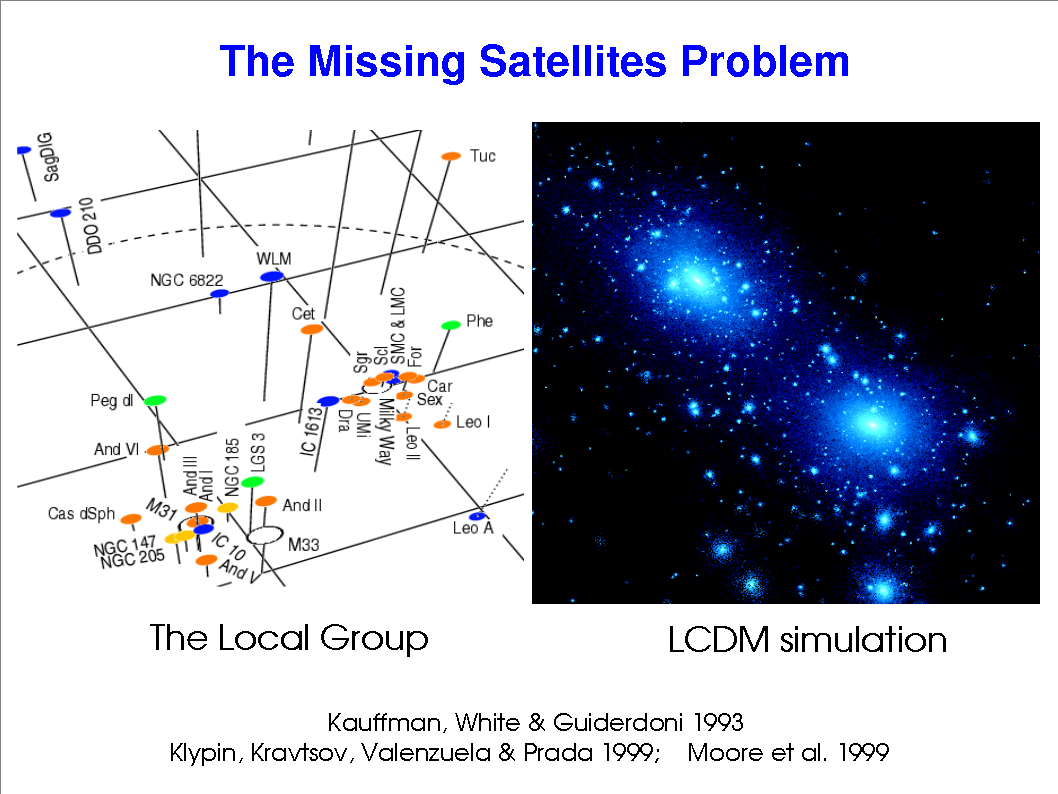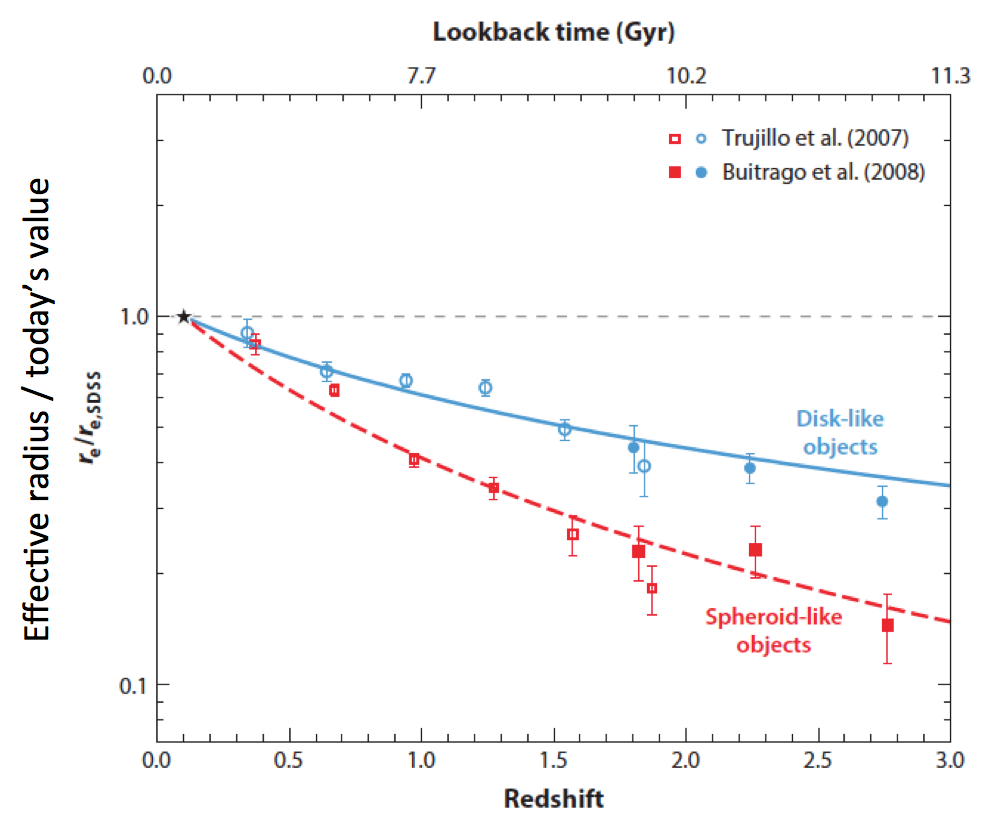Galaxy Formation: Observational Clues
Theoretical arguments
and numerical simulations lead us to the following expectations:
- Small objects should be the first to form
- Structure formation should be hierarchical -- gravity
pulls small things together to form large things.
- Galaxies should form inside out -- inner regions form
first, outer regions form later
- Structure should be scale free: galaxies should be
teeming with low mass companions
That's a lot of "should"s. Is any of this correct?
Observations of the high redshift universe
Complications:
Cosmological effects distort our view of high redshift galaxies:
- High redshift galaxies are faint and small
- Their light has been redshifted
- At cosmological distances, their surface brightnesses are systematically fainter
We use imperfect clocks to judge evolution:
- The formation of stars is not the same thing as the formation of galaxies. Galaxies can have old stars but assemble late.
- Evolution proceeds faster in dense environments: tdyn ~ 1/root(rho). Things that might take time in the field environment can happen faster in dense environments.
- Metallicity is a poor clock for measuring time --
metallicity can build up quickly in regions of high star formation,
much more slowly in regions of low star formation.
High redshift galaxies are intrinsically different
from those around us today -- they are younger. Think of comparing a
massive galaxy nearby to a massive galaxy in the early universe:
- Different stellar ages, so different star formation histories
- Different assembly histories
Reminder: Connection between redshift and age (for H0=72, OmegaM=0.25, OmegaL=0.75):
The Hubble Ultradeep Field
Looking across space and back through time/redshift: how do we assess
redshifts for galaxies?
- Spectroscopic Redshifts: accurate, but time consuming
and need very big telescopes. Example:
 (courtesy Mauro Giavalisco)
(courtesy Mauro Giavalisco)
- Photometric Redshifts: Estimate redshifts based on
colors and brightnessed. Not as accurate, but faster. Example:
How well do they compare? Not bad, if you can tolerate some catastrophically bad outliers:
 (from Brian Mobasher)
(from Brian Mobasher)
So we can look at the deep imaging, estimate redshifts (then
confirm spectroscopically for better accuracy when necessary) and look
at samples of galaxies at different redshifts. From Conselice, ARAA, 2014:
High redshift galaxies often look smaller, lumpier, and bluer than galaxies at intermediate and low redshift.
What about morphology? Look at massive galaxies first (again from Conselice,
ARAA, 2014). The mix of types appears to change with redshift --
Peculiar objects and disky things first, spheroidal types later. But this is almost certainly very dependent on environment and galaxy mass!
For lower mass (but still big, i.e., not dwarf) galaxies things look a bit different:
What about if we look at the stars in nearby galaxies and ask when they
formed? Population synthesis studies of elliptical galaxies by Thomas et al (2010) show downsizing.
Plot inferred star formation rate (y-axis) against time/redshift
(x-axis) for elliptical galaxies of different masses (red: most
massive, blue: less massive).

So wait. Observations of the high redshift universe suggest it takes
time for massive ellipticals to grow, but studies of massive
ellipticals in the local universe suggest these things formed very
early. What's wrong with this picture?
It actually holds together. Massive galaxies today formed their stars
early when they were in smaller clumps, and took time to assemble
themselves together into the massive objects we see today. Lower mass
galaxies we see today are formed their stars later and/or over longer
timescales, on average.
So what about the idea of inside out galaxy formation? Do galaxies grow
their outskirts later than their inner regions? Look at the
changing sizes of massive galaxies, as measured by their effective
radius (Conselice 2014 ARAA):
Also, we know that disk galaxies in the local universe show color gradients: they get bluer (younger?) as you go outwards in the disk.
Outstanding Problems (there are many, here are just a few....)
Missing satellites problem
Dark matter is thought to be scale-free -- dark matter lumps should
exist in ever increasing numbers as you go to smaller and smaller
masses. Simulations show that the Local Group should be littered with
low mass dark matter lumps, but we don't see that many dwarf galaxies. Why not?

Possible explanations:
- Dark matter isn't scale free -- there are low mass cut-offs to dark matter halos (warm-ish dark matter?)
- Gas can't condense inside low mass dark halos (why not?)
- Stars can't form inside low mass dark halos (why not?)
Massive galaxies at high redshift
New surveys are finding massive galaxies at very high
redshift, when the universe was less than a billion years old. How
could these galaxies grow so quickly?
Possible explanations:
- Our estimates of galaxy masses at high redshift are wrong
- Our estimates of galaxy redshifts are wrong
- Our understanding of dark matter and structure formation is wrong
The Cosmological Evolution of Star Formation
Remember that galaxy growth and star formation can be very
different things. Let's forget about galaxies specifically and just ask
how quickly did the universe form its stars?
Star formation in the universe peaked around z ~ 2-3, when
the universe was only a few billion years old. So most of the stars in
the universe are ~ 10 billion years old. But...
- Star formation rates inside individual galaxies look very different
- Galaxies show stellar populations with a wide range of ages
- Many low mass galaxies today show preferentially young stars
So again, we are seeing differences between when stars
formed, where stars formed, and how galaxies assemble. There are
significant variations due to differences in mass and environment.









